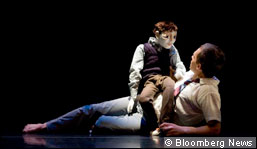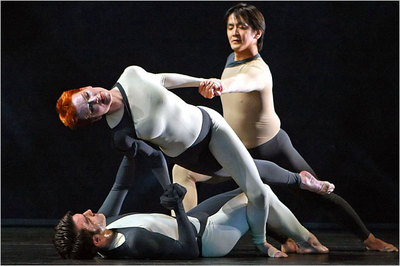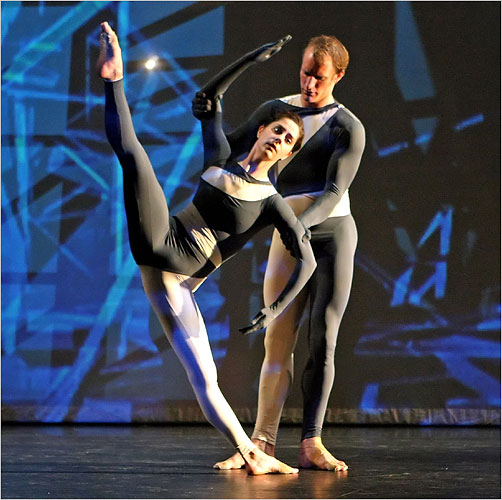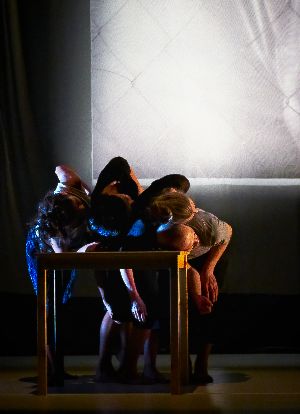foot in mouth: April 2009 Archives
God, did I love the Joe Goode Performance Group's show last week at the Joyce--and I sure didn't expect to from the reviews.
So I was trying to figure out how to talk about him in a way that caught his balancing act, how he manages to vault over cornball sentiment while honoring it. A tricky accomplishment--and I don't know whether I did it justice in this review for the Financial Times (I never know). In the process I ended up thinking about the essential camp impulse: a love of the sensible world. (The pile-on of ornament comes later.)

Here's the review of mine I promised to link to--in the wonderful Financial Times, where the dear, charming Hilary Ostlere used to write.

One of the heavenly tangles in Nearly Ninety (dancers Silas Reiner, Holley Farmer, and Koji Mizuta; Photo: Andrea Mohin/The New York Times)
A few followup notes:
So we critics agreed about one thing, at least, that Nearly Ninety's set by architect Benedetta Tagliabue was massively obtrusive. (Tonya Plank kindly lists all the reviews that have been printed or posted as of yesterday.)
I also agree with Alastair Macaulay in the Times that the number of hapless collaborations--with musicians and particularly artists--has grown in the last several years. The big problem for me is when the companion arts push in a narrative or social direction, precisely where Cunningham doesn't go. (I'm thinking of the Robert Gober slides at the last Joyce Event and Mikel Rouse's folkish songs, with words, for eyeSpace.)
Perhaps Cunningham's age is partly responsible for the bad fits. The artists and musicians he grew up with--artistically, I mean--are mainly dead (Rauschenberg, Cage, Tudor, Feldman). They shared his aesthetic and understood the requirement of his theater--that dancing is the most fleet of the arts and needs to be protected from intrusions in a way that sound and set don't. So if you're going to have a set that covers the whole stage--make it as ineffable as the dance (e.g., Andy Warhol's silver mylar pillows for Rainforest.) If it's going to constrain the dancers, make that constraint something that the choreographer can work with (the rubber bindings for Crises). Same with a set that partially eclipses the dancers. (Rauschenberg's Impressionist costumes that blend with the Impressionist backdrop for Summerspace was a magical effect.)
To work Tagliabue's massive structure into the dance, Cunningham would have had to start way before nearly 90 and end way after (Nearly 95, anyone?) Remember how, to create Ocean, he considered the movement from all 360 degrees of the circular stage? Tagliabue's structure would have offered equal challenges. Without the time for them, this shiplike skeleton reduced Cunningham's multidimensional, anti-proscenium orientation to two dimensions: back and forth, along the lip of the stage.
The music worked for me precisely because it honored Cageian principles and Cageian clarity. (About a decade ago, Sonic Youth did a whole Cage "cover" album, so they're no strangers to the man.) It brought to mind birds rising en masse from a wire, calling into the air; the scrape of industrial metal against metal on an icy early morning; and sometimes just a languid tune on an electric guitar played as if in a livingroom. The musicians attended lovingly to the dance.
I think, as critics, we need to be careful that we're not simply knocking the collaborations' looseness--that Cunningham lets the artists and musicians do what they will. Or if we are, we need to know it.

A not very tender document of the most tender of duets, with Jennifer Goggans and Daniel Squire. In the background a 3-D elaboration of shadows of the monster set behind the scrim (Photo: Andrea Mohin/The New York Times).
PPS: A little more on the pathos of opposite impulses I mentioned in my review: it's why I'll miss Daniel Squire as much as Holley Farmer. He makes a gripping drama out of staying upright. When he does those iconic sideways Cunningham curves, it's as if the earth were calling.
Both he and Farmer distinguish themselves in the company with the contrasting dynamics that play across their body. At the end of Squire's typically angular Cunningham arms are hands with relaxed fingers. Cunningham has said, "Drama is contrast"--and here it is. Squire's body bends as tautly as a bow, but his head turns loosely and sharply. With Farmer, it's her head that reposes regally atop her spine while her torso prickles with twitchiness.
My friend Paul Parish, irregular Foot contributor, writes from Berkeley:
Don't know if you'll be as upset as I am to hear that the projected budget cuts at UC Berkeley are very likely going to wipe out the dance program -- the one in women's phys ed, NOT the Dance program in Performance Studies.
But the phys ed program has been there for a hundred years -- Cal was the first state university to have a physical education program, from the 1890s, and classes for men and women in social dancing were a part of it from the early 1900s, with several different forms of dance taught in the women's program (which also dates WAY back, to ca 1900). It has a distinguished history of serious productions. Though they have been naturally overshadowed by the dept of dance since the Woods arrived, still, I've seen some good stuff at Hearst gym within the last year. There was a substantial article detailing this history in the Journal of the History of the University of California, (Carroll Brentano, ed.) a few years back.
And the classes are popular. They've got modern, jazz, and ballet, and they're massively popular. Sue Li-Jue's ballet class is always huge, it's always overenrolled, and has, I'm told, a couple of TAs to help give corrections.
Other popular programs are also in danger -- judo, for example -- but they may find their angels among those who've benefited from those sports. I haven't heard anything about intercollegiate athletics, but they have their own lobby.
This threatened cut may be a ploy on the part of a chancellor to get angels to step forward, but if so, we'll have to pull our weight just like the martial artists will. And they've got the Sports Section on their team.
It may be up to people who care about dancing to raise a stink, and it may take some agitation from the dance press to get the public interested in this at all. The new fiscal year comes soon, and the squeaky wheel will doubtless get the grease. I'm going to ask Roberto to let me write something in the Bay Area Reporter [SF's gay weekly]--get some Lesbian noise in the air. ~p
UPDATE: Even before Paul sits down to write, some heartening lesbian noise in the air: irregular Foot contributor Eva Yaa Asantewaa interviews two UCB students about the effect the announced cuts might have.
Part 1 and part 2 of her Body and Soul podcast
I wonder what's happening with university dance programs nationwide, whether public universities are more adversely affected than private ones. It would be interesting to see whether the dance programs are affected more than the other arts--or, when they're lodged with PE, which is still often the case, with other sports. The fact that dance is often treated as a sport, without having the ra-ra allegiance of college alums, couldn't be good. At least UCB has a separate department, apart from P.E., for dance studies. At many universities and colleges, the recreation department is it.
I have a review coming out--Monday, I think it is; I will link to it here--on the BAM Cunningham show that runs through Sunday, so I will keep mum on the subject except to say:
It's worth going (of course--this is Cunningham) and it's your last chance to see the the serenely regal and eloquent Holley Farmer and the heartbreakingly immediate Daniel Squire do Cunningham. It's also the last appearance of Koji Mizuta, who for years has been one of my favorite dancers, but he's not given much to do here and he seems to have accepted his forced exit, fading even before the curtain has fallen.
And then there's Cunningham himself, whose dancemaking is still brilliant but whose body won't hold out much longer to do the bidding of his mind.
So, go--and bring flowers. Is there some interdiction against throwing bouquets--or even a single daisy--at modern dance shows? Is it too florid for the avant-garde? I was surprised there were no flowers on opening night.
In the meantime, read Time Out editor and regular Times contributor Gia Kourlas's moving interview with Farmer here.
[UPDATE: Besides the review I have a postscript on the review here.]
The postcard for Vicky Shick's Glimpse--commissioned by the Extremely Hungary Festival and Danspace Project at St. Mark's Church, which presented the dance last weekend--is a photo of a worn Hungarian-English dictionary opened to a page of ps: pelda to pince. Penz follows pentek as money does Friday only to take off on a byway: pep (pulp; the flesh pitted of structure). That's how the soft, sensual Glimpse works, too.
A woman rolls her shoulder, and the motion ripples all the way down her spine through the sexy smile of a hip to a loose foot. She swings her arm before her, where it grazes the earlobe of the dancer facing her and, like an electric current, moves through him. A relationship has formed: between the shoulder, arm, and fingers of one person and the earlobes and spine of another, and thus between two people. The exchanges in Glimpse give off an at once jaunty and ominous air.
The riveting dancers--I was especially glued to Hungarian Hedvig Fekete, the blessedly ubiquitous New Yorker Christine Elmo, and Shick--mix fluid articulation with mildly theatrical insouciance. The movements communicate like a person talking to herself out loud before an imaginary audience. The effect is slyly comic. Shick finds the place where private musing meets public wanting, wondering, and inching forward toward another.
Improbably for someone long associated with the deeply structural and plotless Trisha Brown, for whom she danced and for whom she now teaches, Shick makes dance theater. But in keeping with her inheritance, its origins are strictly physical; it emanates from the body's joints.
Shick thinks associatively; her association for movement traveling through the body is clusters of stories that do not grip one's mind, or the people involved, but instead arouse a suspended state of attention--a readiness for epiphany or communion--as beauty does.
 Glimpse's Christine Elmo, Hedvig Fekete, Diane Madden, and Tamás Bakó (Photo by Sandor Naske)
Glimpse's Christine Elmo, Hedvig Fekete, Diane Madden, and Tamás Bakó (Photo by Sandor Naske)
Critics have long praised Shick, who premieres work every couple of years in downtown spaces, for her subtlety and suggestiveness. They talk of her "elegance." They don't mention her good manners, but she has those, too. In Still Lives, at The Kitchen in 2000, with Juliette Mapp and Jodi Melnick arresting and unflinching, Shick sat on the sidelines like a maid waiting for her bell. Occasionally she rose to fuss over the set or the women's stiff, gorgeous costumes. Her subservience--an accessory to her own creation--was excruciating.
In Glimpse, former Trisha Brown dancer Diane Madden performs that role, entering at intervals to offer crystal shot-glasses of brandy to the dancers. But it's no accident that the help brings hard liquor here: Glimpse possesses a frankness, a bawdiness of intent, that I haven't seen from Shick before--and it's as welcome as a stiff drink.
Two years ago, "at the risk of offending the entire modern dance community" (she probably did), the excellent Lisa Rinehart wrote a highly critical review of Shick for the Danceview Times. The softness of meaning in Shick's work was driving Rinehart crazy. The occasion was Plum House (A Cartoon) and Repair at Dance Theater Workshop (DTW), but the review was far-reaching.
And brutal, like shaking someone who is softly crying until her teeth rattle. But (after recoiling) I had to admit there was something unfinished about the dances of Shick's I'd seen. The problem for me wasn't meandery meaning as much as decorousness--just a few steps removed from the delicacy for which Shick is justly beloved. Her gentility can shade into a self-apology that she seems only half-conscious of; it can linger in the shadows like an anxious mother keeping tabs on her voluptuous, heedless daughter.
Glimpse endows that mother-servant with the hard flesh of will; we can see her clearly now--a powerful counterspirit to a dance so ripe, it's just this side of bruised.
AJ Blogs
AJBlogCentral | rssculture
Terry Teachout on the arts in New York City
Andrew Taylor on the business of arts & culture
rock culture approximately
Laura Collins-Hughes on arts, culture and coverage
Richard Kessler on arts education
Douglas McLennan's blog
Dalouge Smith advocates for the Arts
Art from the American Outback
Chloe Veltman on how culture will save the world
For immediate release: the arts are marketable
No genre is the new genre
David Jays on theatre and dance
Paul Levy measures the Angles
Judith H. Dobrzynski on Culture
John Rockwell on the arts
innovations and impediments in not-for-profit arts
Jan Herman - arts, media & culture with 'tude
dance
Apollinaire Scherr talks about dance
Tobi Tobias on dance et al...
jazz
Howard Mandel's freelance Urban Improvisation
Focus on New Orleans. Jazz and Other Sounds
Doug Ramsey on Jazz and other matters...
media
Jeff Weinstein's Cultural Mixology
Martha Bayles on Film...
classical music
Fresh ideas on building arts communities
Greg Sandow performs a book-in-progress
Harvey Sachs on music, and various digressions
Bruce Brubaker on all things Piano
Kyle Gann on music after the fact
Greg Sandow on the future of Classical Music
Norman Lebrecht on Shifting Sound Worlds
Joe Horowitz on music
publishing
Jerome Weeks on Books
Scott McLemee on books, ideas & trash-culture ephemera
theatre
Wendy Rosenfield: covering drama, onstage and off
visual
Public Art, Public Space
Regina Hackett takes her Art To Go
John Perreault's art diary
Lee Rosenbaum's Cultural Commentary

Recent Comments